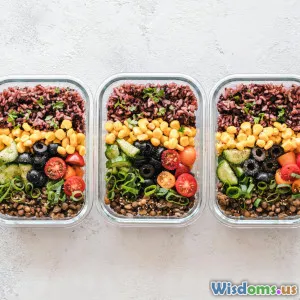
Beginner’s Guide to Smart Meal Prep for Busy Gym Rats
14 min read Unlock efficient, nutritious meal prep tailored for active gym enthusiasts with expert strategies, real examples, tasty recipes, and actionable advice to elevate your performance and simplify healthy eating. (0 Reviews)
Beginner’s Guide to Smart Meal Prep for Busy Gym Rats
Introduction: Why Smart Meal Prep is Your Superpower
If you’ve ever stared at your post-workout reflection, drenched in sweat but plagued by the question "What’s for dinner?"—you’re not alone. For busy gym rats, the gap between iron-clad dedication in the gym and lackluster consistency in the kitchen can undermine hard-won gains. The endless options of takeout or protein bars can feel tempting, but they rarely provide the tailored nutrition your body craves for muscle growth, recovery, and all-day energy.
What if a few hours each week could unleash you from food anxiety, elevate your results, and let you focus entirely on crushing your next workout? That’s the magic of smart meal prep—engineered specifically for high-octane, time-scarce gym enthusiasts. In this guide, we’ll unlock actionable strategies, proven recipes, and real-world tips so meal prep morphs from a boring chore into your ultimate muscle-building, fat-burning tool.
The Science-Backed Benefits of Meal Prep for Athletes
Long considered a secret weapon by top bodybuilders and pro athletes, meal prep isn’t just about convenience. It’s about keeping your hard-earned muscle, fueling high performance, and helping you stay lean—without spending all day in the kitchen.
Consistency is King
A 2020 study in the International Journal of Behavioral Nutrition found that people who prepared meals in advance ate healthier overall, consumed fewer calories, and had more nutrient-rich diets than those who ate spontaneously. For gym enthusiasts, this consistency can mean:
- Steadier energy levels (no more mid-day crashes)
- Better muscle repair via consistent protein intake
- Improved body composition (easier fat loss)
Controlled Macros and Snacking
When you’re in charge of what goes into your food, it’s easier to align meals with your goals, whether that’s bulking up or leaning out. Meal prep puts that control squarely in your hands, minimizing junk food temptations when hunger hits.
Time-Saving for the Hustlers
It might feel like meal prep takes more time at first, but batch-cooking actually saves hours during the week. For example, gym-goers who prepped 3-4 days’ worth of meals on Sunday typically saved an average of 6-8 hours weekly by avoiding daily cooking and shopping.
"Meal prepping every Sunday is a non-negotiable for me. It sets the tone for the whole week—if my meals are sorted, everything else falls into place," says Natalie D., personal trainer and former competitive bodybuilder.
Step 1: Goal Setting—Know What You’re Prepping For
You wouldn’t walk into the gym without a plan, so why freestyle your nutrition? Smart meal prep starts by identifying your primary goal:
- Muscle Gain: Prioritize surplus calories, focus on high-protein and carb-rich meals.
- Fat Loss: Opt for high volume, lower-calorie foods, lean proteins, and slow-digesting carbs.
- Performance: Hit a balance with enough calories and a mix of macros for recovery and training intensity.
Example Macro Targets
- Muscle Gain: 1g protein/lb BW, carbs to fill remaining calories, moderate fats
- Fat Loss: 1-1.2g protein/lb BW, slightly reduced carbs, healthy fats
- Endurance/Performance: 1g protein/lb BW, slightly higher carbs, moderate fats
Tools like MyFitnessPal or Cronometer can help you estimate your macro needs quickly.
Real-Life Example: Mark, a 29-year-old, 175lb office worker and recreational lifter with a busy schedule set a goal to lean down from 18% to 13% body fat before summer. He calculated macros with 2200 kcal/day: 180g protein, 220g carbs, 60g fat—and designed all his prepped meals to fit.
Step 2: Efficient Planning—Map Your Prep Like a Pro
Decide How Many Meals To Prep
- Lunches for the Workweek (5 meals): Most popular, especially if dinners can be improvised.
- Lunch and Dinners (up to 10 meals): Ideal for serious meal preppers during deep training cycles.
- Snacks and Breakfasts: Don’t ignore the "nutritional gaps"—easy protein muffins or overnight oats.
Batch Cook or "Modular" Meal Prep?
- Batch Cooking: Cook large amounts of a few recipes and portion them out for the week. Simple, fast, but can get boring.
- Modular Prep: Prepare building blocks (e.g., grilled chicken, roasted sweet potatoes, assorted veggies, cooked quinoa) and combine creatively for variety.
Pro Tip: Sunday is "peak prep day" for most gym-goers—but spreading prep between Sunday and Wednesday improves freshness and variety, especially for sensitive foods like fish or leafy greens.
Tools to Make Life Easier
- Meal planner apps (Paprika, Plan to Eat)
- Grocery delivery (Instacart, Amazon Fresh)
- High-capacity rice cooker, instant pot, or slow cooker for rapid batch cooking
- Quality storage containers: Look for BPA-free, microwave- and freezer-safe containers in stackable sizes
Step 3: The Ultimate Grocery List for Gym Rats
A well-stocked kitchen is the foundation of stress-free, healthy eating. Here’s what should be on every gym-goer’s shopping list:
Proteins
- Chicken breast/thigh
- Ground turkey, lean beef, salmon
- Eggs, tofu, tempeh, low-fat Greek yogurt
- Canned tuna/salmon
Carbohydrates
- Brown/white rice, quinoa
- Sweet potatoes, whole wheat pasta
- Oats
- Whole grain bread/wraps
Fats
- Avocado
- Olive oil, coconut oil, nut butters
- Chia/flax seeds, almonds, walnuts
Veggies & Fruits
- Broccoli, spinach, kale, peppers, carrots, zucchinis
- Berries, apples, bananas, oranges
Extras
- Low-calorie sauces (salsa, hot sauce, mustard)
- Fresh herbs and spices (parsley, cilantro, garlic)
- Lemon/lime for flavor boosts
Sample Pro Tip: Rotate your protein and carb sources weekly (e.g., cod one week, shrimp the next; swap sweet potato for couscous) to avoid palate fatigue and deliver a wider micronutrient range.
Step 4: Easy, Macro-Friendly Recipes for All Levels
Breakfast Boosters
High-Protein Overnight Oats
- Ingredients: 1/2 cup oats, 1 scoop protein powder, 1/2 cup mixed berries, 1 tbsp chia seeds, 1 cup almond milk
- Prep: Mix all in a jar. Soak overnight. Grab and go.
- Macros: ~28g protein, 45g carbs, 8g fat
Egg Muffins (Prep: 12 muffins, 4 days)
- 8 eggs, spinach, diced peppers, ½ cup cheese, salt/pepper
- Mix, pour into muffin tin, bake 15 mins @ 350°F. Store, reheat as needed.
Lunch/Dinner Power Plates
Tex-Mex Chicken Bowls
- Protein: Grilled chicken strips (pre-marinated with lime, cumin, and chili)
- Carb: Brown rice/quinoa mix
- Veg: Roasted peppers, black beans, corn
- Healthy Fats: Avocado, salsa
- Tip: Layer ingredients separately in storage containers for freshness.
Muscle-Building Buddha Bowls
- Base: Cooked farro or brown rice
- Toppings: Air-fried tofu, shredded carrots, steamed broccoli, tahini-lemon drizzle
Slow Cooker Shredded Beef
- Chuck roast, onions, carrots, spices; slow-cook on low 8 hours. Portion and pair with sweet potato and green veggies.
Snack Attacks
- Protein Bars: Blend oats, nut butter, whey, and dates. Press into a pan. Chill and cut.
- Veggie Chips: Slice zucchini, mist with oil, season, bake until crisp for a low-calorie snack.
Step 5: Keeping Meal Prep Fun, Fresh, and Sustainable
Even the most disciplined gym-goers can get bored with the same chicken and rice after three days. Here’s how to keep your taste buds (and motivation) alive:
Spice Up Your Life
- Experiment weekly with international marinades: think teriyaki, tandoori, chimichurri, lemon-herb.
- Try different textures: grill, roast, sauté, or steam; a sheet pan meal with roasted garlic broccoli can taste worlds apart from steamed.
Add On-the-Go Flexibility
- Pack a lunchbox with reusable cutlery and a freezer pack; leave non-perishable healthy snacks at the office or in your car.
- Mason jar salads: Layer ingredients for grab-and-go salads that stay crisp until ready to eat.
Share the Load
Enlist housemates, family, or friends for Sunday prep—share recipes, dish out meals assembly line-style, and make prep a social event to lighten the load.
Step 6: Overcoming Common Meal Prep Challenges
"I Don’t Have Time"
Start with prepping just two meals a week. As you see the payoff (time, money, energy), scale up. Consider the time saved skipping daily cooking or store runs versus a single focused session.
"Food Gets Boring or Spoils Fast"
Store starches/proteins separate from veggies and sauces until serving. Freeze portions for later in the week. Use airtight glass containers for best longevity.
"Family or Roommates Aren’t On Board"
Create customizable build-your-own meal prep (protein, starch, veg, sauce)—everyone can mix-and-match while meeting their own taste and nutrition needs.
"I’m Not a Chef!"
Start super simple: steam, bake, roast, or grill basics. Try no-recipe recipes—protein, carb, veg, plus a drizzle of olive oil, a squirt of lemon, and cracked black pepper.
Step 7: Practical Meal Prep Workflow—A Sunday in Action
Let’s put it all together. Here’s how your smart meal prep could look for the week:
10:00 AM:
- Review goals and finalize prep recipes (30 mins)
10:30 AM:
- Head to the grocery store or order online (30-45 mins)
11:15 AM:
- Start by baking chicken breast on one tray, sweet potato on another; rice/quinoa in a rice cooker. While those cook, chop veggies and throw together a batch of egg muffins for breakfasts.
12:15 PM:
- Assemble meals into containers, add herbs/sauces separately, label for freshness (pro-tip: date your lids for food safety)
1:00 PM:
- Clean up! Reward yourself with an energizing snack.
By dedicating just three hours, you’ve secured a week’s worth of your favorite, high-performance meals—and extra mental energy to focus on training, work, or family.
Step 8: Tracking Progress and Adjusting Your Prep
Smart meal prep doesn’t end with cooking—it’s about iterative improvement. Track how meals impact your energy, cravings, and body composition using a food journal or tracking app. Take weekly notes:
- Are you losing, gaining, or holding weight?
- Are you hungry or satisfied between meals?
- Do you feel strong at the gym?
Tweak your portions, add or subtract snacks, and keep recipes rotating to match your evolving fitness goals.
Conclusion: Take Control—Fuel Your Goals, One Prep at a Time
Smart meal prep isn’t a rigid rulebook or just for Instagram—it's a living routine built to fit around real lives and real gym ambitions. By making nutrition effortless from week to week, you clear space for your best self—inside and outside the gym.
As the saying goes: "Success is the sum of small efforts, repeated day in and day out." If you prep today, you’ll step into tomorrow fueled, focused, and ready for whatever the world (or your next squat session) throws at you.
So grab your grocery list, set some goals, and embark on your meal prep journey—you just might discover it’s your new favorite power-hour!
Rate the Post
User Reviews
Popular Posts
















